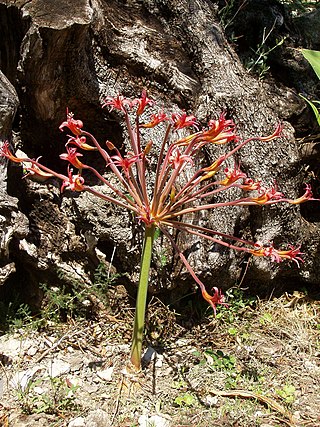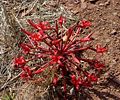Top Qs
Timeline
Chat
Perspective
Brunsvigia
Genus of flowering plants From Wikipedia, the free encyclopedia
Remove ads
Brunsvigia is a genus of African flowering plants in the family Amaryllidaceae, subfamily Amaryllidoideae.[3] It contains about 20 species native to southeastern and southern Africa from Tanzania to the Cape Provinces of South Africa.
Remove ads
Description
Summarize
Perspective
Vegetative characteristics


Brunsvigia are perennial, deciduous, temperate, bulbous herbal plants. Most species have subterranean bulbs but they are usually half-exposed in B. herrei and B. josephinae. Bulbs are tender, usually large (up to 20 cm diameter), winter-growing and summer-dormant, generally flowering in early autumn. Tunics are often thick and cartilaginous, typically brittle and tan-coloured, although they are brown and papery in B. josephinae and B. litoralis.
The leaves are annual; when mature, the leaves are broad and oblong to tongue-shaped. In species with small bulbs – B. radula, B. comptonii, and B. namaquana – there are just two or three leaves per plant but most other species have at least four leaves per bulb. B. josephinae has the distinction of producing as many as 20 leaves. The leaves mostly lie flat on the ground and sometimes press down so firmly that they lie vertically if the bulb is dug up. Only in B. litoralis, B. josephinae, B. grandiflora, B. undulata and B. herrei do the leaves stand clear of the ground. Although usually smooth, the upper leaf surfaces of two Namaqualand species (B. radula and B. namaquana) are covered with straw-coloured bristles and in some populations of B. striata from the southern Cape, they bear soft, scale-like hairs. In the winter rainfall region of southern Africa, the foliage is produced after the flowering heads have been shed, whereas in the summer rainfall region the vegetative and flowering stages often overlap.
Generative characteristics


The scape is firm, to 35 cm, deciduous and breaking at ground level in fruiting time.
The inflorescences, a few- to many-flowered umbels, are particularly conspicuous. In most species the pedicels are long, stiff, straight and radiate outwards to form an almost perfectly spherical head; they elongate and spread after blooming. However, B. litoralis, B. josephinae and B. orientalis differ in having pedicels that curve below each flower. Just three species (B. pulchra, B. marginata and B. elandsmontana) have compact, brush-like inflorescences. The flowers are zygomorphic or almost actinomorphic with short tube, segments spreading-recurved. The six tepals of each flower are free to the base or shortly fused into a tube. Radially symmetrical, trumpet-shaped flowers occur in species with compact, dense inflorescences, whereas bilaterally symmetrical flowers occur in species with open, lax heads. In B. comptonii, B. radula and B. namaquana the flowers are highly asymmetrical as all but one tepal curve upwards. Often the flowers are scented and all produce nectar. Their colour vary from ruby-red to brilliant scarlet or pale to bright pink and in some species the entire inflorescence is attractively coloured. Pink flowers are the norm, whereas red flowers are found in B. marginata, B. orientalis, B. litoralis and B. josephinae. Floral markings are often variable within species but dark veins on the tepals are characteristic for B. bosmaniae and B. gregaria. When in flower, the plants are spectacular but the flowering period is brief and restricted to summer and autumn.
Stamens clustered, arising from the perianth tube, ± declinate or erect, shortly connate at base. Stigma capitate, trilobate (three-lobed). Each locule has 3-10 superimposed ovules whose shape resembles a spinning top. Style filiform, declinate. The water-rich, non-dormant, ovoid, reddish green seeds are borne in large, dry capsules that are spindle-shaped or three-angled, obtuse or acute, transversally veined, and often heavily ribbed. Capsules are dehiscent loculicidally or breaking unevenly. Dehiscence in most species of Brunsvigia is somewhat tardy and confined to the apex of the capsule, hampered below by heavy ribs that keep the septa closed for most of their length.[4]
Remove ads
Cytology
The number of chromosomes is 2n = 22.[5][6][7]
Taxonomy
Summarize
Perspective
It was published by Lorenz Heister in 1755.[1][8][9] The type species is not designated.[2] The genus Brunsvigia was named after the House of Braunschweig [Brunswick]-Lüneburg,[8][5] specifically honouring the Duke of Brunswick who promoted the study of plants, including the beautiful Cape species B. orientalis. The name was first used in 1753 by Lorenz Heister, a German surgeon and botanist, to describe a single bulb received in 1748 by Gustaaf Willem van Imhoff from Ryk Tulbagh at the Cape.[10]
Species
Ecology
Pollination
Brunsvigia is the only genus of Amaryllideae in which several species have stout, somewhat tubular, brilliant scarlet, pink, or red flowers that are adapted to bird pollination.[6]
Habitat
Brunsvigia occurs in semi-arid regions[13] in sandy, well-draining soil.[8] It occurs both in winter rainfall and summer rainfall regions.[13]
Conservation
Brunsvigia litoralis is endangered due to housing development,[14][15] and invasive plants.[14]
Use
Horticulture
It has been used in intergeneric hybridisation with Amaryllis. Such hybrids are named × Amarygia.[16][17]
References
Bibliography
External links
Wikiwand - on
Seamless Wikipedia browsing. On steroids.
Remove ads







